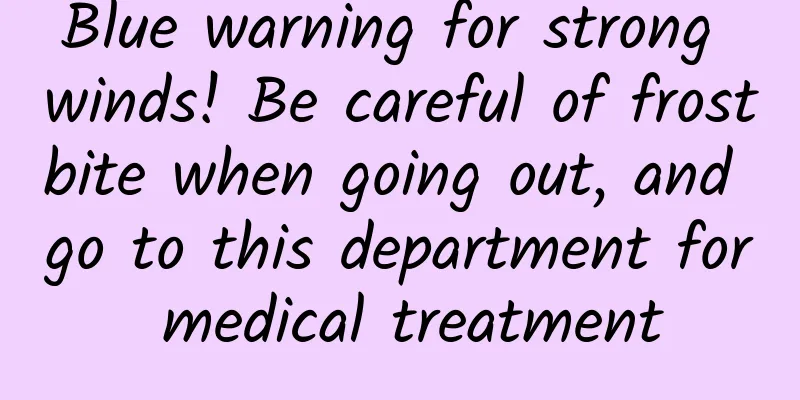Blue warning for strong winds! Be careful of frostbite when going out, and go to this department for medical treatment

|
Review expert: Wang Xuejiang, professor at Capital Medical University Beijing Meteorological Observatory issued a blue warning signal for strong winds at 15:45 on December 29, 2024. Although the weather is getting colder, it does not stop people from engaging in outdoor activities. If the warm-keeping measures are not in place, outdoor activities are very likely to cause frostbite. So, how should we deal with frostbite? What is it? Which department should we go to in the hospital? PART.01 What is frostbite Frostbite is the damage to local or whole body tissues caused by cold and dampness. When a part or the whole body of a person is in a low temperature environment for a long time, the body temperature is lost rapidly, the surface blood vessels spasm, the blood flow is reduced, and the flow slows down, which causes tissue ischemia and hypoxia, cell damage, and ultimately leads to a serious drop in local or whole body temperature, causing injury. Source: Qianku.com The incidence of frostbite is highest when the ambient temperature is between -25°C and -30°C. The most common sites of frostbite are the lower limbs (especially the toes, which are at the distal end of the limbs and have poor blood circulation), followed by the face, ears, and fingers . PART.02 Causes of frostbite In addition to being related to the cold environment , frostbite is also related to humidity, the body's decreased ability to resist cold , and poor local blood circulation . Environmental impact Cold weather, including low temperatures, humidity, cold winds, and sudden changes in weather, can accelerate the body's heat dissipation. The lower the ambient temperature, the more heat the body consumes, and the more likely it is to get frostbite. If you are in a low-temperature environment, your body is partially damp or you are wearing damp clothing, this will also accelerate the loss of heat. In addition, standing in a cold environment or immersing in cold water for a long time, or accidentally being exposed to such an environment for a long time, can cause local blood circulation disorders and lead to frostbite. Source: Qianku.com When a part of the human body comes into direct contact with extremely cold metal, stone or other objects with strong thermal conductivity, the body temperature suddenly drops, causing frostbite. Dry ice, liquid nitrogen, liquid helium, Freon and other items cool quickly and can quickly cause tissue damage. The longer the contact time, the more severe the frostbite. Personal factors Poor warming measures or inappropriate clothing. Effective warming and appropriate clothing are the best measures to prevent frostbite. In cold areas, protective warming measures must be taken, especially for the ears, nose, hands, feet and other parts that are prone to frostbite. In addition, if the shoes and socks are too tight or standing still for a long time, it will also lead to heat loss and cause frostbite. Physical health is also a cause of frostbite. When a person is in a state of fatigue, weakness, or mental stress, anxiety, trauma, blood loss , etc., the body's ability to adjust and adapt to external temperature changes may be weakened, causing local heat loss and leading to frostbite. In addition, young children and the elderly , as well as patients with diseases such as cerebrovascular diseases, are more susceptible to frostbite. PART.03 Symptoms and dangers of frostbite According to the degree of tissue damage, frostbite is generally divided into four stages of development: Source: Qianku.com First degree frostbite First-degree frostbite is the mildest. The damage is usually in the epidermis. The frozen part of the skin will be red, swollen and congested, and will feel hot, itchy and accompanied by a burning sensation. The symptoms of first-degree frostbite will disappear after a few days. After healing, there will be no scars except for the epidermis falling off. The common "frostbite" belongs to first-degree frostbite. Second degree frostbite Second-degree frostbite will damage the dermis. After frostbite, in addition to redness, swelling and congestion, blisters will appear, the blisters are filled with bloody fluid, and edema may occur deep inside. The pain is very intense, but the skin will feel dull. Third degree frostbite Third-degree frostbite will cause the skin to appear purple-brown or black and lose the sense of pain. After third-degree frostbite, the injured part is not easy to heal, and scars will be left after healing. There may also be long-term allergies or pain. Fourth degree frostbite Fourth-degree frostbite is very serious. In addition to damaging the skin and subcutaneous tissue, it can also damage muscles and even bones, leading to necrosis. It can also cause systemic frostbite, which is freezing. It is often accompanied by consciousness, mental disorders, and physical movement disorders, and even slow breathing, slow heart rate, arrhythmia, etc., which can eventually lead to death. PART.04 How to treat frostbite In a cold environment, if your skin feels numb, red and swollen, or turns pale and feels cold and stiff, you may have frostbite. After the symptoms of frostbite appear, you should leave the low temperature and humid environment as soon as possible to prevent further freezing. If it is mild frostbite, you can use warm water to warm the frostbitten part, or place the frostbitten part in a warm place or clamp it under the armpit, etc., to promote blood circulation and let the skin recover slowly. If the skin is obviously red and swollen and blisters have appeared, or even lose consciousness, it is best not to puncture the blisters by yourself. You need to see a doctor as soon as possible and receive treatment with the help of a doctor. Source: Qianku.com Do not warm yourself by the fire immediately after frostbite or place the frostbitten part near electric blankets, electric heaters or other heating devices, so as to avoid the high temperature causing blood vessels to expand rapidly and aggravate tissue damage. In addition, do not wipe or rub the frostbitten part with snow, as this "home remedy" cannot relieve frostbite. After frostbite, you should also pay attention to preventing infection, keep the affected area clean and hygienic, and do not scratch it with your hands. PART.05 Which department should I go to for frostbite treatment? The hospital does not have a special frostbite department. The injury mechanism of frostbite is similar to that of burns, both of which are caused by changes in environmental temperature. So in fact, the treatment and treatment of frostbite is usually the responsibility of the burn department . Therefore, when frostbite occurs, you can go to the burn department of the hospital for treatment. |
<<: How long does it take to produce a new energy heavy truck? "Less than 5 minutes!"
Recommend
How to promote and attract traffic to the mini program mall and how to promote WeChat mini program traffic?
WeChat currently has nearly 1 billion users, and ...
50 stunning scenery photos to take you through the Hexi Corridor!
Not to the Northwest I don't know the vastnes...
Are you still spending money to buy traffic? Which of the five major traffic channels do you choose?
When we do marketing promotion, we can choose cha...
Why is the upper limit of sound 194 decibels?
What is the loudest sound in everyone's mind?...
Douyin book list account practical teaching, novices can easily get started with zero basic knowledge
Douyin book list account practical teaching, novi...
Do people spend more than 200 days in the toilet in their lifetime? Let's see what terrible diseases toilet renovations prevent! Severe ones can be fatal!
If we calculate based on a life span of 80 years,...
Introducing 5 data-driven and practical customer acquisition methods
Admittedly, in many cases, the acquisition of new...
Fei Ge's book Douyin popular traffic monetization, live broadcast popular traffic selling goods to make money secrets, earn 5224 yuan a day
Fei Ge's book Douyin popular traffic monetiza...
5 Laws of Strategy | Use the first one and you can ignore the other four
Before formulating a communication strategy, mark...
How much is the price for being a Shaoyang Automobile Mini Program agent? Shaoyang Automobile Mini Program Agent Price Inquiry
Why should you be an agent for WeChat Mini Progra...
How to build a live broadcast room scene? Tips for setting up a live broadcast room!
Your colleagues will always be your best teachers...
In memory of the 2022 Republic, 17 academicians have been lost
This year 17 academicians have passed away Commem...
Can't eat food that's one day past its expiration date? These foods have no expiration date, don't waste them!
gossip Food cannot be eaten if it is one day past...
10 classic marketing planning cases!
When doing marketing planning , there are three t...
During Oscar season, iPad says it can make movies?
Apple unveiled its latest iPad ad hours before th...









